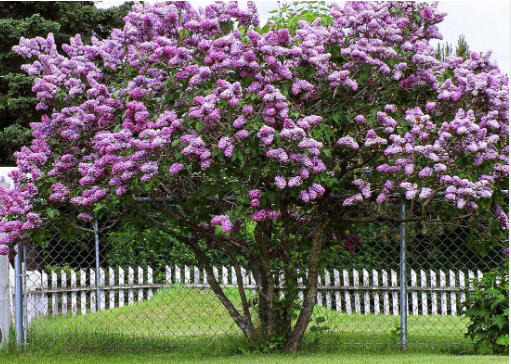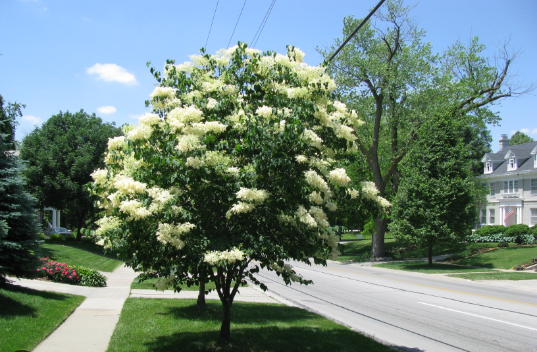The lilac tree, scientifically known as Syringa, is a member of the Oleaceae family and comprises about 20 to 25 species of flowering woody plants. Lilacs are beloved for their fragrant, colorful blooms and are often found in gardens, parks, and landscapes around the world.
Lilacs are native to the temperate regions of Europe and Asia. They are found in habitats like woodlands and rocky slopes, but are most commonly associated with open woodlands and scrubby areas.
Lilacs were introduced to North America in the 18th century by European settlers. They quickly became popular garden plants due to their beauty and adaptability to different climates.

Botanical Characteristics
Form and Structure: The lilac tree presents itself as a deciduous shrub or small tree with a robust structure. Typically, lilacs have a rounded or vase-shaped crown, with branches that spread outwards in a graceful manner.
Foliage: The leaves are opposite, meaning they grow in pairs along the stems, and they are typically heart-shaped or ovate. These leaves are usually vibrant green in color.
Flowers: The flowers are generally tubular with four petals and can be purple, pink, white, and even yellow in color. They bloom in spring and early summer, depending on the species and cultivar.
Fragrance: When the tree is in bloom, the flowers emit a sweet, heady scent that fills the surrounding air and can be enticing pollinators and humans alike. Some people described it as nostalgic and romantic.
Fruit: After flowering, lilacs produce small, dry capsules containing numerous seeds.
Size: Many lilac varieties are cultivated as compact shrubs with a mature height of about 4 to 8 feet (1.2 to 2.4 meters).Some lilac species and cultivars have a more tree-like growth habit, developing into medium-sized specimens that can reach heights of 10 to 15 feet (3 to 4.5 meters) or more.These lilac trees often feature a single trunk.
Life Span: Under optimal growing conditions and with proper care, lilac trees can live for several decades, about 50 years or more. Some species are inherently longer-lived than others, while certain cultivars may have been bred for specific traits at the expense of longevity.
Varieties of Lilac Trees

Photo of Japanese Tree Lilac is from John Fech, Nebraska Extension Educator
Over the centuries, numerous cultivars and hybrids of lilacs have been developed through selective breeding for characteristics such as flower color, size, and fragrance. Many of these cultivars are now widely cultivated in gardens and parks worldwide. Most bloom in late May; however there are early spring, mid spring, and late-season blooming varieties, as well as new re-blooming varieties. Among the common varieties include:
Common lilac (Syringa vulgaris)
Common lilac also referred to as French lilac features profusion of fragrant flowers in shades of purple, pink, white, and even blue. This iconic lilac species is hardy in USDA Hardiness Zones 3 to 7, making it well-suited to colder climates with harsh winters. With its upright growth habit and heart-shaped leaves, the common lilac adds a touch of old-world charm to gardens and landscapes, blooming reliably in late spring to early summer.
The Dwarf Korean lilac (Syringa meyeri)
Dwarf Korean lilac offers compact growth and abundant blooms that range in color from soft lavender to lilac-pink. Hardy in USDA Hardiness Zones 3 to 7, this charming lilac shrub delights with its profuse clusters of fragrant flowers and glossy green foliage. Perfect for smaller gardens or as a border plant, the Dwarf Korean lilac enchants with its resilience and adaptability to various growing conditions.
Chinese lilac (Syringa × chinensis)
The Chinese lilac is a hybrid of Syringa vulgaris (common lilac) and Syringa persica (Persian lilac). Hardy in USDA Hardiness Zones 3 to 7, Chinese lilacs feature colorful blooms in hues of lavender, pink, and white, accompanied by glossy foliage and an elegant form.
Persian lilac (Syringa persica)
Persian lilac is native to the rocky slopes and woodlands of the Middle East and Eastern Europe. Hardy in USDA Hardiness Zones 4 to 8, Persian lilacs boast slender branches adorned with clusters of fragrant blooms in shades of lavender and pink. These enchanting trees add a touch of elegance to gardens and landscapes, blooming profusely in late spring to early summer and attracting pollinators with their sweet fragrance.
Japanese lilac (Syringa reticulata)
Originating from East Asia, particularly Japan and Korea, commands attention with its upright growth habit and showy flower clusters, reminiscent of cherry blossoms. Hardy in USDA Hardiness Zones 3 to 7, Japanese lilacs dazzle with their large, creamy white blooms and glossy foliage. These majestic trees bloom later in the spring to early summer, extending the lilac season.
Miss Kim Lilac (Syringa patula)
Miss Kim Lilac produces an abundance of fragrant flowers in late spring to early summer, typically in May or June. The flowers usually have a lavender-blue hue. It is is generally hardy in USDA Hardiness Zones 3 to 8. One of the distinguishing features of Miss Kim Lilac is its foliage, which emerges in spring with a reddish-purple tint before maturing to a rich green color.
Trees that look like Lilac Tree
Chaste Tree (Vitex agnus-castus)
Chaste tree, also known as Vitex or Monk’s Pepper, is a deciduous shrub or small tree with long spikes of lavender-blue flowers. While the flowers are not as fragrant as lilacs, they have a similar appearance and bloom in summer, adding color and texture to the garden.
Mock Orange (Philadelphus spp.):
Mock orange is a deciduous shrub with fragrant, white flowers that resemble those of citrus trees. While the fragrance is different from lilacs, the white flowers and overall appearance of mock orange can evoke a similar visual impact in the landscape.
Rose of Sharon (Hibiscus syriacus):
Rose of Sharon is a deciduous shrub with large, showy flowers that bloom in late summer to early fall. While the flowers are not as fragrant as lilacs, their colorful blooms and shrub-like growth habit can provide a similar focal point in the garden.
Kolkwitzia (Kolkwitzia amabilis)
Kolkwitzia, also known as beauty bush, is a deciduous shrub with arching branches and pink, bell-shaped flowers that bloom in late spring to early summer. While its flowers are smaller than lilac blooms, they have a similar appearance and fragrance.
Wisteria (Wisteria spp.)
Wisteria is a deciduous climbing vine or shrub known for its long, cascading clusters of fragrant flowers. Some varieties, such as Wisteria sinensis or Wisteria floribunda, bear clusters of lavender or white flowers that resemble lilac blooms in appearance and fragrance.
Deutzia (Deutzia spp.)
Deutzia is a deciduous shrub with delicate, star-shaped flowers that bloom in spring and summer. Some cultivars, such as Deutzia gracilis ‘Nikko’, produce clusters of white flowers that resemble lilac blooms and have a similar fragrance.
How to grow and care for lilac tree
| Sunlight | Lilac trees thrive in full sun to partial shade, ideally receiving at least 6 hours of sunlight daily. |
| Soil | Well-draining soil is essential for lilacs. Sandy loam with a slightly acidic to neutral pH (6.0-7.0) is ideal. |
| Watering | Water deeply but infrequently, allowing the soil to dry out between waterings. Avoid overwatering, which can lead to root rot. |
| Fertilization | Apply a balanced fertilizer in early spring before new growth begins, following package instructions. Avoid excessive nitrogen, which can promote foliage growth at the expense of flowers. |
| Pruning | Prune lilac trees immediately after flowering to remove spent blooms and shape the plant. Remove dead or diseased branches as needed. |
| Mulching | Apply a layer of organic mulch, such as wood chips or compost, around the base of the tree to retain moisture, suppress weeds, and regulate soil temperature. |
| Winter Protection | In colder climates, protect young or newly planted lilac trees from frost and freezing temperatures by mulching around the base and wrapping the trunk with burlap. |
| Disease and Pest Control | Monitor for common lilac pests and diseases such as powdery mildew, aphids, and bacterial blight. Treat as needed with appropriate fungicides or insecticides. |
| Propagation | Propagate lilac trees through softwood or hardwood cuttings, division, or layering. Softwood cuttings are typically taken in early summer, while hardwood cuttings are taken in late autumn or winter. |
| Container Gardening | Lilac trees can be grown in large containers, provided they have adequate drainage and space for root growth. Choose dwarf or compact varieties for container cultivation. |
| Companion Planting | Plant companion species such as early-blooming bulbs (e.g., daffodils, tulips), perennial flowers (e.g., peonies, daylilies), or evergreen shrubs (e.g., boxwood) to complement the lilac’s beauty and extend the season of interest in the garden. |
| Seasonal Maintenance | Conduct regular inspections throughout the growing season to monitor for signs of stress, disease, or pest infestations. Address issues promptly to maintain the health and vitality of the lilac tree. |
Common diseases that affect lilac tree
Powdery Mildew (Microsphaera alni)
Powdery mildew is a fungal disease that appears as a white, powdery growth on the leaves, stems, and buds of lilac trees. It thrives in warm, humid conditions and can weaken the plant over time, leading to stunted growth and reduced flowering. To prevent powdery mildew, ensure good air circulation around the tree, avoid overhead watering, and prune out infected branches. Fungicidal sprays may be necessary for severe infestations.
Bacterial Blight (Pseudomonas syringae pv. syringae)
Bacterial blight is a bacterial disease that causes dark brown or black spots to develop on the leaves, stems, and flowers of lilac trees. It spreads rapidly in wet weather and can lead to defoliation and dieback if left untreated. To control bacterial blight, prune out infected branches, disinfect pruning tools between cuts, and avoid overhead watering. Copper-based fungicides may also help prevent the spread of the disease.
Verticillium Wilt (Verticillium spp.)
Verticillium wilt is a fungal disease that affects the vascular system of lilac trees, causing wilting, yellowing, and necrosis of the leaves. It spreads through contaminated soil and can persist for years, making it difficult to control. To prevent verticillium wilt, avoid planting lilac trees in soil where infected plants have previously grown and maintain proper soil drainage and fertility. There are no effective chemical treatments for verticillium wilt, so prevention is key.
Phytophthora Root Rot (Phytophthora spp.):
Phytophthora root rot is a fungal disease that attacks the roots of lilac trees, causing wilting, yellowing, and stunted growth. It thrives in waterlogged soil and can be exacerbated by poor drainage and overwatering. To prevent phytophthora root rot, plant lilac trees in well-draining soil, avoid overwatering, and maintain proper soil pH. Fungicidal drenches may be necessary for severe infestations.